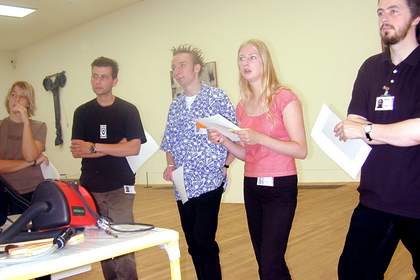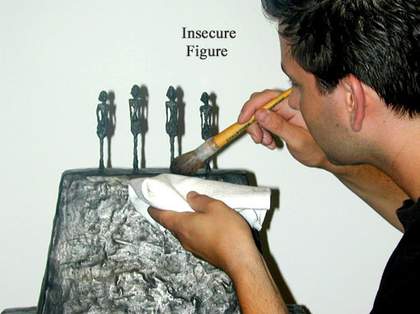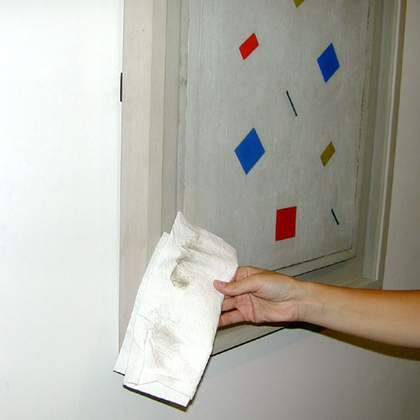Increasing visitors numbers mean more cleaning
One impact of the large numbers of visitors to Tate Modern is that dirt and dusty material is deposited within display spaces.
With Tate conservators already working to capacity to service rotating displays at four Tate sites, loans to other institutions, an active acquisitions programme and the ongoing examination and treatment of works in Tate’s collection it soon became difficult for them to carry out the increased amount of routine cleaning of works of art on display at Tate Modern.
The solution was to establish a dedicated maintenance team of gallery assistants, trained by conservators and art handlers to maintain the highest standards of display presentation. This would include routine tasks such as dusting frames, cleaning plinths and plinth covers, touching up gallery walls and checking for and reporting any areas of concern to curators and conservators.
Establishing the group
Soon after Tate Modern opened, the Gallery Assistants Maintenance Group was established. As well as serving a practical purpose and ensuring that the works of art on display at Tate Modern received due care and attention, the creation of the group brought with it a number of other benefits for Tate staff:
- Gallery assistants had an active part to play in the appearance of the displays, giving them a stake in maintaining the highest level of display presentation. They received training from conservators, thereby adding to their skills and understanding of caring for the collection.
- Art handlers were freed from routine cleaning and were therefore able to concentrate on those maintenance tasks that only they should perform, for example, cleaning large works of art or those displayed high up, which can only be reached using specialist equipment, such as powered access platforms, scaffolding and high ladders.
- Conservators with their specialist training and expertise were left to care for works that were delicate or problematic.
- The scheme provided Visitor Services with a training opportunity to offer gallery assistants.
Training and implementation
Training for the Gallery Assistants Maintenance Group took place over a four-week period in the summer of 2001. Each week a different aspect of caring for the collection was covered, with training, demonstrations and practical supervision being carried out by conservators:
- Week one – Sculpture conservation: dry cleaning methods were demonstrated and supervised cleaning of sculptures carried out.
- Week two – Information about treating glazing and frames, supervised cleaning in gallery.
- Week three – Environmental issues, including procedures for reporting excessive light levels.
- Week four – Paper conservation, cleaning glazing.

Fig.1 The first day of training
Initially, the activity of the croup was restricted to Tate collection works. Later, loans to the collection and to temporary exhibitions were included in the group’s maintenance programme.
Unframed paintings were still allocated to conservators for cleaning, and unglazed frames were only to be cleaned by the Gallery Assistants Maintenance Group when a paintings conservator was present. Good communication between conservators and the group was essential to the smooth running of the programme, so that any concerns could be reported and dealt with.

Fig.2 Alberto Giacometti, Four Figurines on a Base 1950/1965, cast c.1965–6
Quatre figurines sur base
Bronze; object: 1562 x 419 x 314 mm; sculpture
An insecure figure was discovered on the sculpture

Fig.3 Dirt removed from the glazing fitted into the display frame
Conclusion
The formation of the Gallery Assistant Maintenance Group at Tate Modern to carry out routine display maintenance required the collaboration of many different groups, both at Tate Modern and across Tate as a whole. In addition to keeping the displays in good order, lines of communication have been established that greatly benefit conservation’s role in contributing to the smooth operation of Tate Modern. It is hoped that where conservators in other institutions face similar challenges with regard to high levels of display maintenance, the model presented here might provide both a prompt to assess the need for such a group and practical assistance, if Tate’s example is used as a precedent.
